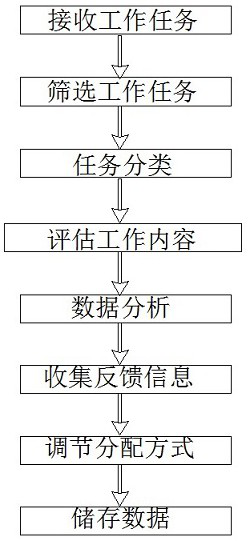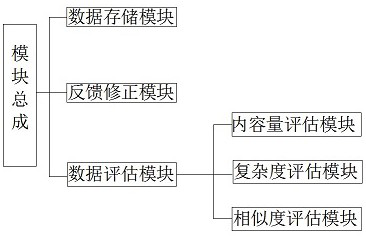Work platform task workload prediction method based on feedback correction
A working platform and forecasting method technology, applied in forecasting, instrumentation, data processing applications, etc., can solve problems such as data not being updated in time, evaluation results with too much error, and platform users cannot be satisfied, so as to improve accuracy and improve data quality. Basis, evaluate the effect of high accuracy
- Summary
- Abstract
- Description
- Claims
- Application Information
AI Technical Summary
Problems solved by technology
Method used
Image
Examples
Embodiment 1
[0033] refer to Figure 1-3 , a method for predicting the workload of work platform tasks based on feedback correction, including the following steps:
[0034] S1: Receive work tasks, the contracting party publishes the work task requirements to the work platform, and the work platform receives various tasks;
[0035] S2: Screen work tasks, conduct preliminary screening of work tasks, and reject some tasks that cannot be completed;
[0036] S3: Task classification, after counting all tasks, classify them, and initially divide them into three categories: general purpose, industrial design and software development;
[0037] S4: Evaluate the work content, evaluate the work content of the receiving task, and the evaluation is classified into content evaluation, complexity evaluation, and similarity evaluation;
[0038] S5: Data analysis, comparing the original data, comparing some variables in the existing work tasks with the original data, to re-analyze the workload situation, ...
Embodiment 2
[0044] refer to Figure 1-3 , a method for predicting the workload of work platform tasks based on feedback correction, including the following steps:
[0045] S1: Receive work tasks, the contracting party publishes the work task requirements to the work platform, and the work platform receives various tasks;
[0046] S2: Screen work tasks, conduct preliminary screening of work tasks, and reject some tasks that cannot be completed;
[0047] S3: Task classification, after counting all tasks, classify them, and initially divide them into three categories: general purpose, industrial design and software development;
[0048] S4: Evaluate the work content, evaluate the work content of the receiving task, and the evaluation is classified into content evaluation, complexity evaluation, and similarity evaluation;
[0049] S5: Data analysis, comparing the original data, comparing some variables in the existing work tasks with the original data, to re-analyze the workload situation, ...
Embodiment 3
[0055] refer to Figure 1-3 , a method for predicting the workload of work platform tasks based on feedback correction, including the following steps:
[0056] S1: Receive work tasks, the contracting party publishes the work task requirements to the work platform, and the work platform receives various tasks;
[0057] S2: Screen work tasks, conduct preliminary screening of work tasks, and reject some tasks that cannot be completed;
[0058] S3: Task classification, after counting all tasks, classify them, and initially divide them into three categories: general purpose, industrial design and software development;
[0059] S4: Evaluate the work content, evaluate the work content of the receiving task, and the evaluation is classified into content evaluation, complexity evaluation, and similarity evaluation;
[0060] S5: Data analysis, comparing the original data, comparing some variables in the existing work tasks with the original data, to re-analyze the workload situation, ...
PUM
 Login to View More
Login to View More Abstract
Description
Claims
Application Information
 Login to View More
Login to View More - Generate Ideas
- Intellectual Property
- Life Sciences
- Materials
- Tech Scout
- Unparalleled Data Quality
- Higher Quality Content
- 60% Fewer Hallucinations
Browse by: Latest US Patents, China's latest patents, Technical Efficacy Thesaurus, Application Domain, Technology Topic, Popular Technical Reports.
© 2025 PatSnap. All rights reserved.Legal|Privacy policy|Modern Slavery Act Transparency Statement|Sitemap|About US| Contact US: help@patsnap.com



